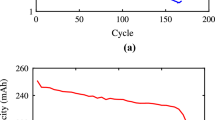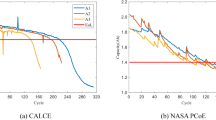Abstract
This paper proposes a novel empirical model for the remaining useful life prediction of lithium-ion battery. The proposed model is capable of modeling both the global degradation and local degradation of lithium-ion battery aging process. The global degradation process is regarded as the ideal aging profile without any interference by regeneration phenomenon. However, the regeneration phenomenon inevitably occurs in practical usage of lithium-ion battery and affects the local degradation significantly. Therefore, we separate the local degradation process from the global degradation process to represent the local battery aging process affected by regeneration phenomenon. We unify the modeling method for the global and local degradation process by exponential functions with cleverly designing of the corresponding cycles. The particle filter framework is employed to estimate the model parameters with measurement data. The future capacity is predicted after the identification, and the remaining useful life is extracted by calculating the difference between the predicted capacity and failure threshold. Model comparisons on benchmark battery datasets have been conducted. The results demonstrate that our proposed method is capable of capturing the degradation and regeneration phenomena, and the remaining useful life prediction performance of our proposed model is better than state-of-the-art modeling methods.








Similar content being viewed by others
Explore related subjects
Discover the latest articles, news and stories from top researchers in related subjects.References
Arulampalam MS, Maskell S, Gordon N, Clapp T (2002) A tutorial on particle filters for online nonlinear/non-gaussian bayesian tracking. IEEE Trans Signal Process 50(2):174–188
Birkl CR, Roberts MR, McTurk E, Bruce PG, Howey DA (2017) Degradation diagnostics for lithium ion cells. J Power Sour 341:373–386
Choi SS, Lim HS (2002) Factors that affect cycle-life and possible degradation mechanisms of a li-ion cell based on licoo2. J Power Sour 111(1):130–136
Daigle M, Kulkarni CS (2016) End-of-discharge and end-of-life prediction in lithium-ion batteries with electrochemistry-based aging models. In: AIAA Infotech@ aerospace, p 2132
Deng LM, Hsu YC, Li HX (2017) An improved model for remaining useful life prediction on capacity degradation and regeneration of lithium-ion battery. In: Annual conference of the prognostics and health management society 2017 (PHM 2017)
Dubarry M, Liaw BY, Chen MS, Chyan SS, Han KC, Sie WT, Wu SH (2011) Identifying battery aging mechanisms in large format li ion cells. J Power Sour 196(7):3420–3425
Eddahech A, Briat O, Bertrand N, Delétage JY, Vinassa JM (2012) Behavior and state-of-health monitoring of li-ion batteries using impedance spectroscopy and recurrent neural networks. Int J Electr Power Energy Syst 42(1):487–494
Eddahech A, Briat O, Vinassa JM (2013) Lithium-ion battery performance improvement based on capacity recovery exploitation. Electrochim Acta 114:750–757
Fernández I, Calvillo C, Sánchez-Miralles A, Boal J (2013) Capacity fade and aging models for electric batteries and optimal charging strategy for electric vehicles. Energy 60:35–43
Gordon NJ, Salmond DJ, Smith AF (1993) Novel approach to nonlinear/non-gaussian bayesian state estimation. In: IEE proceedings F (radar and signal processing), IET, vol 140, pp 107–113
He W, Williard N, Osterman M, Pecht M (2011) Prognostics of lithium-ion batteries based on dempster-shafer theory and the bayesian monte carlo method. J Power Sour 196(23):10314–10321
Huang C, Wang Z, Zhao Z, Wang L, Lai CS, Wang D (2018) Robustness evaluation of extended and unscented kalman filter for battery state of charge estimation. IEEE Access
Huggins R (2008) Advanced batteries: materials science aspects. Springer, Berlin
Jin G, Matthews DE, Zhou Z (2013) A bayesian framework for on-line degradation assessment and residual life prediction of secondary batteries inspacecraft. Reliab Eng Syst Saf 113:7–20
Klass V, Behm M, Lindbergh G (2014) A support vector machine-based state-of-health estimation method for lithium-ion batteries under electric vehicle operation. J Power Sour 270:262–272
Liu D, Pang J, Zhou J, Peng Y, Pecht M (2013) Prognostics for state of health estimation of lithium-ion batteries based on combination gaussian process functional regression. Microelectron Reliab 53(6):832–839
Liu K, Hu X, Wei Z, Li Y, Jiang Y (2020) Modified gaussian process regression models for cyclic capacity prediction of lithium-ion batteries. IEEE Trans Transp Electr 5(4):1225–1236
Liu K, Li Y, Hu X, Lucu M, Widanage WD (2020) Gaussian process regression with automatic relevance determination kernel for calendar aging prediction of lithium-ion batteries. IEEE Trans Ind Inform 16(6):3767–3777
Liu K, Shang Y, Ouyang Q, Widanage WD (2020) A data-driven approach with uncertainty quantification for predicting future capacities and remaining useful life of lithium-ion battery. IEEE Trans Ind Electron, pp 1–1
Long B, Xian W, Jiang L, Liu Z (2013) An improved autoregressive model by particle swarm optimization for prognostics of lithium-ion batteries. Microelectron Reliab 53(6):821–831
Lu L, Han X, Li J, Hua J, Ouyang M (2013) A review on the key issues for lithium-ion battery management in electric vehicles. J Power Sour 226:272–288
Miao Q, Xie L, Cui H, Liang W, Pecht M (2013) Remaining useful life prediction of lithium-ion battery with unscented particle filter technique. Microelectron Reliab 53(6):805–810
Micea MV, Ungurean L, Carstoiu GN, Groza V (2011) Online state-of-health assessment for battery management systems. IEEE Trans Instrum Meas 60(6):1997–2006
Olivares BE, Munoz MAC, Orchard ME, Silva JF (2013) Particle-filtering-based prognosis framework for energy storage devices with a statistical characterization of state-of-health regeneration phenomena. IEEE Trans Instrum Meas 62(2):364–376
Omar N, Monem MA, Firouz Y, Salminen J, Smekens J, Hegazy O, Gaulous H, Mulder G, Van den Bossche P, Coosemans T et al (2014) Lithium iron phosphate based battery-assessment of the aging parameters and development of cycle life model. Appl Energy 113:1575–1585
Orchard M, Tang L, Saha B, Goebel K, Vachtsevanos G (2010) Risk-sensitive particle-filtering-based prognosis framework for estimation of remaining useful life in energy storage devices. Stud Inform Control 19(3):209–218
Orchard ME, Lacalle MS, Olivares BE, Silva JF, Palma-Behnke R, Estévez PA, Severino B, Calderon-Muñoz W, Cortés-Carmona M (2015) Information-theoretic measures and sequential monte carlo methods for detection of regeneration phenomena in the degradation of lithium-ion battery cells. IEEE Trans Reliab 64(2):701–709
Orchard ME, Vachtsevanos GJ (2009) A particle-filtering approach for on-line fault diagnosis and failure prognosis. Trans Inst Meas Control 31(3–4):221–246
Petzl M, Kasper M, Danzer MA (2015) Lithium plating in a commercial lithium-ion battery-a low-temperature aging study. J Power Sour 275:799–807
Qin T, Zeng S, Guo J, Skaf Z (2016) A rest time-based prognostic framework for state of health estimation of lithium-ion batteries with regeneration phenomena. Energies 9(11):896
Safari M, Morcrette M, Teyssot A, Delacourt C (2009) Multimodal physics-based aging model for life prediction of li-ion batteries. J Electrochem Soc 156(3):A145–A153
Saha B, Goebel K (2007) Battery data set. https://ti.arc.nasa.gov/tech/dash/pcoe/prognostic-data-repository/battery. Accessed 03 May 2016
Saha B, Goebel K (2009) Modeling li-ion battery capacity depletion in a particle filtering framework. In: Proceedings of the annual conference of the prognostics and health management society, San Diego, pp 2909–2924
Saha B, Goebel K, Christophersen J (2009) Comparison of prognostic algorithms for estimating remaining useful life of batteries. Trans Inst Meas Control 31(3–4):293–308
Saha B, Goebel K, Poll S, Christophersen J (2009) Prognostics methods for battery health monitoring using a bayesian framework. IEEE Trans Instrum Meas 58(2):291–296
Tang S, Yu C, Wang X, Guo X, Si X (2014) Remaining useful life prediction of lithium-ion batteries based on the wiener process with measurement error. Energies 7(2):520–547
Van Der Merwe R, Doucet A, De Freitas N, Wan EA (2001) The unscented particle filter. In: Advances in neural information processing systems, pp 584–590
Wang D, Miao Q, Pecht M (2013) Prognostics of lithium-ion batteries based on relevance vectors and a conditional three-parameter capacity degradation model. J Power Sour 239:253–264
Wang D, Yang F, Tsui KL, Zhou Q, Bae SJ (2016) Remaining useful life prediction of lithium-ion batteries based on spherical cubature particle filter. IEEE Trans Instrum Meas 65(6):1282–1291
Wu J, Zhang C, Chen Z (2016) An online method for lithium-ion battery remaining useful life estimation using importance sampling and neural networks. Appl Energy 173:134–140
Xing Y, Ma EW, Tsui KL, Pecht M (2013) An ensemble model for predicting the remaining useful performance of lithium-ion batteries. Microelectron Reliab 53(6):811–820
Yang B, Liu R, Zio E (2019) Remaining useful life prediction based on a double-convolutional neural network architecture. IEEE Trans Ind Electron 66(12):9521–9530
Yang F, Wang D, Xing Y, Tsui KL (2017) Prognostics of li (nimnco) o2-based lithium-ion batteries using a novel battery degradation model. Microelectron Reliab 70:70–78
Yang N, Zhang X, Shang B, Li G (2016) Unbalanced discharging and aging due to temperature differences among the cells in a lithium-ion battery pack with parallel combination. J Power Sour 306:733–741
Acknowledgements
This work was in part supported by National Natural Science Foundations of China under Grant Nos. 61872351, 51906160, International Science and Technology Cooperation Projects of Guangdong under Grant No. 2019A050510030, the Natural Science Foundation of Guangdong Province under Grant 2018A030313747, the Strategic Priority CAS Project under Grant XDB38000000, the Major Projects from General Logistics Department of People’s Liberation Army under Grant AWS13C008 and Natural Science Foundation of Top Talent of SZTU (Grant No. 1814309011180003).
Author information
Authors and Affiliations
Corresponding author
Ethics declarations
Conflict of interest
The authors declare that they have no conflict of interest.
Additional information
Publisher's Note
Springer Nature remains neutral with regard to jurisdictional claims in published maps and institutional affiliations.
Rights and permissions
About this article
Cite this article
Deng, L., Shen, W., Wang, H. et al. A rest-time-based prognostic model for remaining useful life prediction of lithium-ion battery. Neural Comput & Applic 33, 2035–2046 (2021). https://doi.org/10.1007/s00521-020-05105-0
Received:
Accepted:
Published:
Issue Date:
DOI: https://doi.org/10.1007/s00521-020-05105-0




